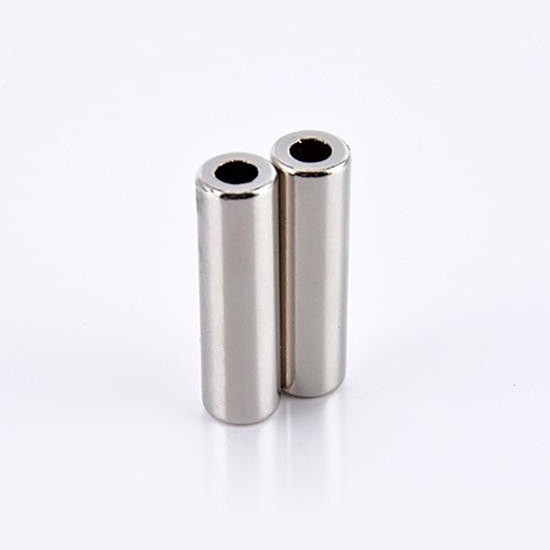How to optimize the performance of a cylinder shape magnet in a specific application?
 Jul 07, 2025|
Jul 07, 2025| Optimizing the performance of a cylinder shape magnet in a specific application is a multi - faceted challenge that requires a deep understanding of both the magnet's properties and the requirements of the application. As a cylinder shape magnet supplier, I have witnessed firsthand the importance of these optimization techniques in various industries. In this blog, I will share some key strategies to enhance the performance of cylinder shape magnets in specific applications.
Understanding the Basics of Cylinder Shape Magnets
Before delving into optimization, it's crucial to understand the fundamental characteristics of cylinder shape magnets. Cylinder shape magnets come in different sizes and materials, such as neodymium, ferrite, and samarium - cobalt. Each material has its own unique magnetic properties, including magnetic strength, coercivity, and temperature stability.
The Cylindrical Permanent Magnet is a popular choice due to its strong magnetic field and long - lasting performance. Smaller variants like Small Cylindrical Magnets are often used in precision applications, while Hollow Cylinder Magnets offer special design possibilities, such as allowing the passage of rods or wires through their center.
Material Selection
The choice of magnet material is the first step in optimizing performance. Neodymium magnets are known for their high magnetic strength, making them ideal for applications where a strong magnetic field is required, such as in motors and generators. However, they have a relatively low Curie temperature, which means they can lose their magnetism at high temperatures.
Ferrite magnets, on the other hand, are more resistant to high temperatures and are less expensive. They are commonly used in applications where cost - effectiveness and temperature stability are important, such as in speakers and magnetic separators.
Samarium - cobalt magnets offer a good balance between high magnetic strength and high - temperature stability. They are often used in aerospace and military applications, where performance under extreme conditions is crucial.
When selecting a material for a specific application, it's important to consider factors such as the required magnetic field strength, the operating temperature range, and the budget.
Magnet Design and Geometry
The design and geometry of the cylinder shape magnet can significantly affect its performance. The length - to - diameter ratio of the magnet, for example, can influence the magnetic field distribution. A longer magnet generally produces a more uniform magnetic field along its axis, while a shorter and wider magnet may have a stronger magnetic field at the poles.
In some applications, the shape of the magnet's ends can also be important. Rounded or chamfered ends can reduce the magnetic field leakage at the edges, while flat ends may be more suitable for applications where the magnet needs to be in direct contact with other components.
Hollow cylinder magnets offer unique design advantages. The hollow center can be used to reduce the weight of the magnet or to accommodate other components, such as sensors or electrical wires. The thickness of the wall of the hollow cylinder also affects the magnetic properties, and it needs to be carefully designed based on the application requirements.
Magnetization Direction
The magnetization direction of the cylinder shape magnet is another critical factor. There are two main types of magnetization: axial magnetization, where the magnetic field is aligned along the axis of the cylinder, and radial magnetization, where the magnetic field is perpendicular to the axis.
Axial magnetization is commonly used in applications such as magnetic couplings and linear actuators, where a strong magnetic field along the axis is required. Radial magnetization, on the other hand, is often used in applications such as magnetic sensors and motors, where a magnetic field perpendicular to the axis is needed.
In some cases, a custom magnetization pattern may be required to meet the specific needs of the application. This can be achieved through specialized magnetization processes, which are often available from advanced magnet suppliers.
Magnetic Circuit Design
The design of the magnetic circuit in which the cylinder shape magnet is used is essential for optimizing its performance. A magnetic circuit consists of the magnet, the magnetic core (if any), and the air gap between the magnet and the other components.
The magnetic core can be made of materials with high magnetic permeability, such as iron or steel. It helps to concentrate the magnetic field and increase the magnetic flux density in the air gap. The shape and size of the magnetic core need to be carefully designed to match the magnet and the application requirements.
The air gap between the magnet and the other components also affects the magnetic field strength. A smaller air gap generally results in a stronger magnetic field, but it may also increase the mechanical stress on the magnet and the other components. Therefore, the air gap needs to be optimized based on a balance between the magnetic field strength and the mechanical requirements.
Temperature Management
Temperature can have a significant impact on the performance of cylinder shape magnets. As mentioned earlier, different magnet materials have different temperature stabilities. In applications where the operating temperature is high, it's important to take measures to manage the temperature.
One way to manage temperature is to use a heat sink or a cooling system. A heat sink can absorb and dissipate the heat generated by the magnet, while a cooling system can actively remove the heat from the magnet.
Another approach is to select a magnet material with a higher Curie temperature. For example, samarium - cobalt magnets can operate at higher temperatures compared to neodymium magnets.
Coating and Protection
Cylinder shape magnets are often exposed to harsh environments, such as moisture, chemicals, and mechanical wear. To protect the magnet and maintain its performance, a suitable coating can be applied.
Common coating materials include nickel, zinc, and epoxy. Nickel coating provides good corrosion resistance and a smooth surface finish. Zinc coating is also corrosion - resistant and is often used in applications where cost is a concern. Epoxy coating can provide additional protection against mechanical damage and can also be used to improve the adhesion of the magnet to other components.
Testing and Quality Control
Before using the cylinder shape magnet in a specific application, it's important to conduct thorough testing and quality control. This includes measuring the magnetic field strength, the magnetic field distribution, and the temperature stability of the magnet.
Magnetic field strength can be measured using a gaussmeter or a fluxmeter. The magnetic field distribution can be visualized using techniques such as magnetic field mapping. Temperature stability can be tested by subjecting the magnet to different temperature conditions and measuring the change in its magnetic properties.
Quality control also involves inspecting the physical properties of the magnet, such as its dimensions, surface finish, and coating quality. Any defects or deviations from the specifications can affect the performance of the magnet and need to be corrected before the magnet is used in the application.


Conclusion
Optimizing the performance of a cylinder shape magnet in a specific application requires a comprehensive approach that takes into account factors such as material selection, magnet design, magnetization direction, magnetic circuit design, temperature management, coating and protection, and testing and quality control.
As a cylinder shape magnet supplier, we are committed to providing high - quality magnets and technical support to our customers. We have the expertise and resources to help you select the right magnet for your application and optimize its performance.
If you are interested in purchasing cylinder shape magnets or need more information about optimizing their performance in your specific application, please feel free to contact us for further discussion and procurement negotiation. We look forward to working with you to meet your magnet needs.
References
- Handbook of Magnetic Materials. K. H. J. Buschow, ed.
- Magnetic Materials and Their Applications. E. C. Stoner and E. P. Wohlfarth.
- Permanent Magnet Design and Application Handbook. R. J. Parker.

